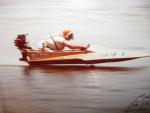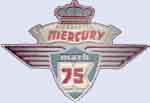
Originally Posted by
smiley

Here are the OMC specs
Minimum combustion chamber at T.D.C to top of spark plug hole 13.5 cm cubed. I do not know the volume of the spark plug hole.
cylinder bore .030 over at 2.218 in.
Crank stroke is 1.760 inch +/- .008
effective cylinder travel above exhaust port to top of stroke 1.203 in.
I have documented cold and after run compression but have found cold tests to be easier and more frequent to do and record.
How can one lap rings to pistons where there are pins in the ring lands, do you just clean out the ring lands with a broken/filed ring or do you just let it be?
Also there is a discussion about minimum oil vs more oil in the gas. Minimum gets you more fuel for combustion; more oil gives a better seal? Is this logic correct? What have your tests shown? I have heard of fuel rations ranging from 20:1 to 50:1.
Also, what is the ideal mix ratio of say 110 racing fuel to standard marine pump gas? Does higher octane provide a longer power stroke duration? Is this beneficial? What is the overiding factors to shoot for? I know that OMCs are very low on torque so energy management in the turns is critical.
Bob Smiley


 Thanks:
Thanks:  Likes:
Likes: 


 Reply With Quote
Reply With Quote

 All numbers are approx but you should read similiar values from your compression gage. If you don't have a good gage get one and protect it.
All numbers are approx but you should read similiar values from your compression gage. If you don't have a good gage get one and protect it.



 , if tach properly hooked up barrel running should not make a didderence. What type of tach?
, if tach properly hooked up barrel running should not make a didderence. What type of tach?
Bookmarks